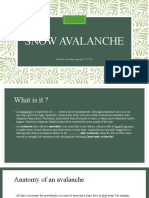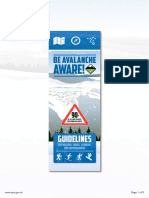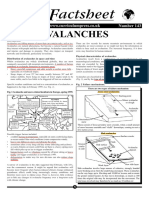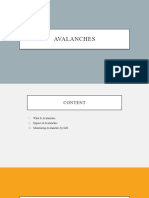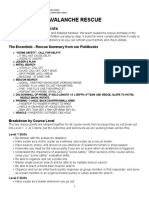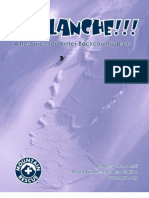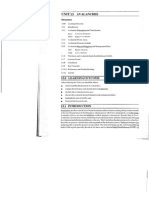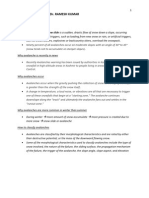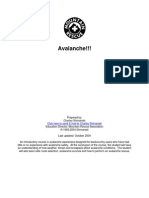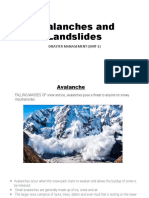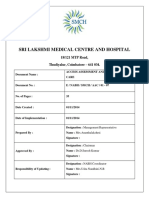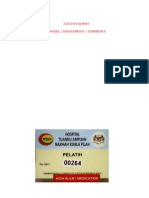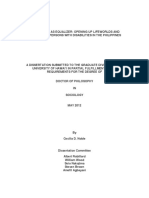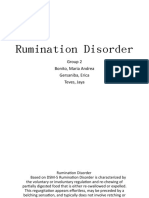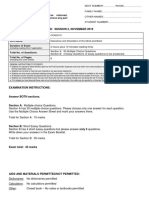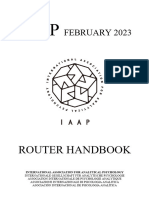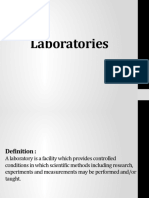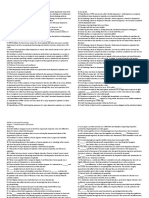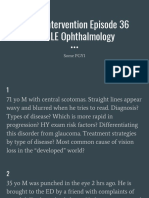Basic avalanche knowledge
safety academy
Guide Book
for backcountry skiers, free riders and snowmobilers
�imProving your safety
with Smart-Antenna-Technology
The smart-antenna-technology analyzes the position of the antennas in the avalanche and automatically switches to the optimal transmission antenna. the result: 43% more range, regardless of the beacon used for searching.
Tested and recommended
Official supplier to
ortovox.com
�safety academy Guide Book
A safety initiative by the safety academy mountain schools, the vdbs and ortovoX
Our short handbook should not be seen as a miraculous solution against avalanches. It should at most impart and consolidate basic knowledge and give people an understanding of the laws of nature. No matter whether you go backcountry skiing or free riding or snowmobiling, you will never be able to fully eliminate the risk. considered behavior alone will give you years of pleasure to come in your sport.
vdbs.de
Peter geyer VDBS
ortovox.com/safetyacademy
privat
ortovox.com
Safety Academy Guide Book
Photo
editorial
�avalanches and how they are caused
A look at the photo tells the attentive observer many factors about the cause of this avalanche:
weather terrain snow cover human
A lot of new snow combined with wind and cold temperatures. Untouched and steep. Probably 30 or more. A snow slab becomes unstable when there is a weak layer in the snow cover. Even when highly motivated, people should always act responsibly and in a predominantly defensive manner. The prevalent risk was not detected here.
avalanches and how they are caused
Safety Academy Guide Book
Photo
The picture shows the most dangerous type of avalanche for winter sportspeople, the slab avalanche.
Ralf Hochhauser
�contents
4 8 11 15 16 18 20 22 23 24 26 27 28 29 avalanches and what causes them avalanche factors Weather Terrain Snow covering Human backcountry Planning Avalanche report Selecting your destination Avalanche emergency equipment on the sloPes Avalanche transceiver partner / group check Basic ascent principles Alarm signs Systematic snow cover analysis Basic descent principles Avalanche accidents
Concept & Design by ortovoX (Hendrik Reschke, Stefanie Rieder, Volker Heuer) in Taufkirchen, Germany
carbon neutral
print production
By carbon neutral printing, ortovoX gives a small contribution to the preservation of our planet.
natureOffice.com | DE-248-565587
Safety Academy Guide Book
contents
�slab avalanches
In case of a slab avalanche, snow masses usually come loose with a linear crack in floes, which suddenly slip down on a sliding layer.
conditions for slab avalanches
+ Compact snow (often drift snow) + Poor bond to the layer underneath (low shear resistance = weak snow layer) + Steepness (>30)
Christian Brecheis, Patrick Nairz Photo
slab avalanches
Safety Academy Guide Book
�how slab avalanches are triggered
An avalanche can be triggered just from the low additional load of one person on the snow surface.
ascent
1 2 times body weight.
kick turn
2 3 times body weight.
short turn
4 5 times body weight.
fall
6 7 times body weight.
Klaus Fengler
Photo
bear in mind: The weight of new snow, rain, warm temperatures or intense sunshine can also lead to avalanches being triggered naturally!
how slab avalanches are triggered
Safety Academy Guide Book
�avalanche factor Weather - Precipitation
Whether or not snowfalls influence the risk of an avalanche depends on the conditions during the period of precipitation: critical amount of new snow in the last 1 3 days 10 20 cm (4 - 8) in case of unfavorable conditions 20 30 cm (4 - 12) in case of average conditions (mixture of favorable / unfavorable) 30 60 cm (12 - 24) in case of favorable conditions
favorable conditions
No or little wind Temperatures just below 0 C (32 F), especially when snow starts falling Rain turning to snow
unfavorable conditions
Strong wind (around 50 km/h / 30 mph) Low temperatures Poor layer composition (meltfreeze crust, snowed-in surface hoar, hard ice or very old layers)
avalanche factor
Weather - precipitation
Photo
Christian Brecheis
�avalanche factor Weather - Temperature
One of the general conditions to be noted during and after snowfall is the temperature. Cold, warm air and sunshine have a huge influence on the processes of change in the snow cover and also on the avalanche risk.
massive warming slow, moderate warming warming during day cooling at night cold long-lasting major cold sPell
It is very critical, but its effects can be easily evaluated. Helps to set the snow cover and the bond between the layers.
Causes the snow cover to compact perfectly, yet attention must be paid to the avalanche situation deteriorating during the course of the day from east to west. (Attention in case of snowfall after such a phase; a critical weak layer is often formed) Preserves existing risks and delays the setting process. Fully eases the avalanche situation, as the structure of the crystals change and become loose.
Photo
Klaus Fengler
avalanche factor
Weather - temperature
�avalanche factor Weather - Wind
Wind is the ultimate architect of avalanches. Just small amounts of snow combined with strong wind can lead to a critical avalanche situation.
on the windward side (compacted snow)
on the lee side (snowdrift)
bear in mind: On the mountains you should avoid gullies, troughs and bowls, as snowdrifts accumulate here. Just as dangerous are the lee areas behind ridges, as well as the cornices above them that are in danger of breaking off. on the lee side Behind ridges Under inclination changes on the windward side At the foot of steep ridges In troughs and gullies
10
avalanche factor
Weather - wind
Photo
Klaus Fengler
�avalanche factor Terrain - Slope shape
task Trace a route on the terrain picture that presents the lowest avalanche risk for you and your party. Solution on the next page.
Photo
Claus Streitschek
Terrain shapes influence the formation of avalanches because they have a crucial influence on the wind direction and speed and also on the extent of snow fractures. gullies, troughs and sloPe changes encourage avalanches. These shapes of terrain help to form snowdrifts on the lee side and compacted snow build-ups on the windward side.
avalanche factor
Terrain - slope shape
11
�avalanche factor Terrain - Slope shape
Danger! crevasses comPacted snow gully steeP! comPacted snow
corn
ice
avalanche
g arnin n 40 ine w a moray steeper th tl mos
The ideal route makes the best use of the terrain shapes that are safe from avalanches: ribs, as the snow is often blown off them and snowdrifts hardly accumulate there broad ridges, as the wind hardly ever allows snowdrifts to form here either dePressions, as they support the snow cover by means of small slope shapes the tour avoids: steeP sloPes, staying away from riskier avalanche-prone areas by maintaining appropriately safe distances. bowls & gullies, since these are areas where snowdrifts can often accumulate. cornices, because they can break off unexpectedly at any time. On the leeward side, underneath the cornice, one often finds accumulations of dangerous snowdrifts.
12
Terrain - slope shape
avalanche factor
Photo
Claus Streitschek
�avalanche factor Terrain - Slope direction
70% of all avalanche accidents happen on north-facing sloPes (W to E) and 56% in the pure north sector (NW to NE). The reason for the frequency of accidents on these aspects is that the snow cover sets more slowly due to the low amount of sunshine. Powder, but also the danger, therefore, remains in place longer.
s
illustration Tobias Wandres
Due to longer periods of sunshine, south-facing sloPes often have a more stable snow cover composition. Only 30% of all avalanches go off on a southern asPect (SE to SW).
bear in mind, however, that a critical avalanche situation often relates to all asPects!
avalanche factor
Terrain - slope direction
13
�avalanche factor Terrain - Slope steepness
Around 97% of all avalanche accidents happen on slopes with an inclination of over 30 (designated in the avalanche report as steep slopes). In the case of 84% of accidents, the steepest part of the slope is at least 35. When determining the steepness of a slope, the steepest part of a slope that measures at least 10 x 10 m (30 x 30 ft) is looked at. As a guideline, the following slope steepness can be seen as safe subject to the avalanche report:
1 2 3 4 5
14
Apart from extremely steep terrain, conditions generally safe from avalanches.
- avoid eXtremely steeP terrain - keeP your distance on slopes that are so steep that kick turns make them easier to ascend. - cross sloPes over 30 one at a time - avoid sloPes over 35 in those sloping areas that are mentioned in the avalanche report or appear particularly dangerous. - In addition, in all sloping areas: Behave as at Level 2
- avoid sloPes over 30. - Even in flatter areas, bear in mind the possibility of naturally triggered avalanches from catchment areas above.
illustration Tobias Wandres
Backcountry skiing, free riding and snowmobiling are generally not Possible.
Steepest part of the slope according to topographic map
30
40
avalanche factor
terrain - slope steepness
�avalanche factor Snow cover
A snow slab becomes unstable when there is a weak layer in the snow cover. The following circumstances have a positive influence on the stability of the snow cover:
knowledge of the ground underneath The more grassy / flattened the ground underneath, the higher the risk of ground avalanches (usually in spring). Knee timber, rocky terrain or forest with trees very close together reduce the risk.
Michael Mller and Christian Brecheis
number of crossings Heavily used slopes over the whole area before the last snowfall can reduce sliding layers and ensure greater stability.
Photo
avalanche factor
Snow cover
15
�avalanche factor Human
16
avalanche factor
Human
Photo
humans represent the most imPortant avalanche factor in recognizing and avoiding the risk of an avalanche. eXPerience, knowledge, Personal ability and aPProPriate behavior are contributing factors for triggering avalanches. That is why conscientious route Planning, attentive observation and risk-conscious decision making are an essential part of any off-piste activity.
Bernd Ritschel
�Planning a tour
The basis for preparing any tour is the information from the avalanche rePort, weather rePort, tour guides and toPograPhic maPs.
Photo
Patrick Nairz
Safety Academy Guide Book
Planning a tour
17
�Planning a tour Avalanche report
avalanche rePorts are normally issued every day in the relevant months and provide data from observers, monitoring stations, snow section recordings and local experts. Just looking at the danger level is not enough. The avalanche report contains all the relevant information about the weather, snow cover, assessment of the avalanche risk (danger areas, additional load, trigger probability) and a forecast of the expected development. tiP: On ortovox.com you can find all the relevant information at a glance!
level
snow cover Generally well compacted and stable.
low
moderate
2 3
Only moderately compacted on some steep slopes, otherwise generally well compacted.
considerable
Only moderate to weak compact on many steep slopes.
high
4 5
Unstable in most places.
Is generally unstable.
extreme
18
Avalanche report
Planning a tour
�Planning a tour Avalanche report
info graPhics Avalanche Warning Service Tyrol
trigger Probability Avalanches can generally only be triggered in case of large additional loads in isolated places on extremely sloping terrain. Only small natural avalanches are possible.
Possible particularly in case of large additional loads, especially at the specified steep slopes. Large natural avalanches are not anticipated.
Avalanches may be triggered by just a small additional load, especially at the specified steep slopes. Some medium, but also big natural avalanches in isolated cases are possible. Avalanches are probable from just a low additional load on many steep slopes. Many medium, but also big natural avalanches in isolated cases can be expected.
Many large natural avalanches can be expected, even on moderately steep terrain.
Planning a tour
Avalanche report
19
�15 Hangneigung 0
Steepness of slope
Planning a tour Selecting your destination
ortovox.com as well as the ortovoX mountain tours aPP (Bergtouren App) offers you many destinations, which you can choose according to a wide variety of criteria. The topographic maps shown there are no substitute for conventional maps, however, with as small a scale as possible. When planning, it is essential to choose a route suitable for the avalanche situation. sloPe steePness, asPect and avalanche terrain traP must be checked in case of any danger situation.
40 35 30
25
20
tiP: Slope steepness can be read from tour maps with a scale of 1:25000 with the aid of the mark on the side.
4 9 8 7 6
3 1 1000 m 500 m
60 50
20
Planning a tour
Selecting your destination
�Planning a tour Tips
alternative destination If the conditions found on the terrain do not match your assumptions, then an alternative destination planned out in advance is the safe solution. time Planning Always allow extra time. The reality in the mountains is usually different from plans made on the sofa. never go alone Even minor accidents can have fatal consequences.. grouP size The smaller the group, the more flexible you are. 8 persons is seen as the maximum. grouP aPPearances Always act responsibly and do not be misdirected into more risk. consideration Always act with the weakest skier in mind and show consideration
Photo
Bernd Ritschel
Planning a tour
Tips
21
�Planning a tour Emergency avalanche equipment
A comPlete set of emergency avalanche equiPment enables you to locate and save your friends in case of emergency. Emergency equipment cannot prevent an avalanche or potential burial.
check list
avalanche transceiver 3 antennas and a flagging function are standard. shovel A hacking function saves you invaluable time. Probe A quick and stable quickassembly system is essential. backPack Make sure it has an emergency compartment. helmet Now part of the standard equipment on the slopes. first-aid kit and bivouac sack Can save lives and make emergencies more bearable. mobile Phone You can alert the rescue by dialing 112 (Europe) / 911 (US)
11 min
25 min
1-2 h
imPortant Only a complete set of emergency avalanche equipment enables you to locate and save your friends in case of emergency. Emergency equipment cannot prevent an avalanche or potential burial.
22
Planning a tour
Emergency avalanche equipment
illustration Tobias Wandres
�on the sloPes Avalanche transceiver partner / group check
At the starting point of the tour, the transmitting and receiving function on all avalanche transceivers should be checked: grouP leader check 1. He switches his transceiver to transmit. 2. All others to receive. grouP check 1. Leader switches to send, all others to receive. 2. The group members walk past the leader one by one 5 m (16 ft) interval. 3. After a successful check, the leader also switches to transmission mode. before every tour The batteries should be checked and replaced immediately if necessary.
Photo
Kllaus Fengler
Avalanche transceiver partner / group check
on the sloPes
23
�on the sloPes
1
Adapt your route to the terrain. gullies, troughs and unnecessary steeP sloPes should be avoided, as they may hide danger.
2
Go around snowdrifts and accumulations of comPacted snow
3
Actively watch out for alarm signals or systematically analyze the snow cover (Page 27).
4
Get your bearings regularly both on the terrain and on the maP and keep a regular check on your tracks.
24
on the sloPes
Basic ascent principles
�Basic ascent principles
5
Check whether the sloPe steePness matches the danger situation (see Page 19). A slope measuring device, the ortovoX s1+ or your ski poles can be used as measuring instruments (pendulum method: ortovox.com). You can basically tell when ascending slopes from approx. 30 or more, as you will automatically switch from arcing to kick turns.
6
You should either ascend steeP sloPes one by one or keep a distance of at least 10 m (30 ft).
7
Claus Streitschek
Photo
recent avalanches are clear indicators of a high risk of avalanches. Be sure to keep a safe distance away by giving the area a large berth.
Basic ascent principles
on the sloPes
25
�on the sloPes Alarm signs
naturally triggered avalanches usually occur when there is a high avalanche risk. Especially when the weather warms up in the daytime in spring, they serve as an indicator for danger. Heavy PreciPitation, particularly rain, rises in temPerature or wind can lead to an increased avalanche risk. whumPing or settling noises the dull whumping sound, when the snow settles, indicates the biggest danger of all. You should abort the tour immediately and return to safe terrain. cornices are a sign of high winds. Dangerous snowdrifts accumulate on the lee side.
cracks on the snow cover signal that it is ready to break.
watch out: If you are unsure of the danger, you should assess the layers of snow by means of a systematic snow cover analysis. If there are still safety concerns, turning back is the only right decision!
26
Alarm signs
on the sloPes
Photos Patrick Nairz
�on the sloPes Systematic snow cover diagnosis
Since the winter of 1998/99, systematic snow cover diagnostics have been taught in our training courses run by the Bavaria Avalanche Warning Service. An attempt is made here, using individual sPot tests (small block test), to transfer certain processes and properties of weak layers to the area or the individual slope and to then evaluate them. This kind of diagnosis is very quick and meaningful. You can find the comprehensive descriptions of the systematic snow cover analysis online at: ortovox.com
Photo
Bernd Ritschel
Systematic snow cover diagnosis
on the sloPes
27
�on the sloPes Basic descent principles
It is possible to descend in a group only under very safe conditions. A safety interval of approx. 50 m (160 ft) is recommended on any descent. In case of less clearly safe conditions, skiers should descend one by one. The leader should go first and wait at regular intervals away from the descent line at a safe and protected place (assembly point). In case of Poor visibility and Poor snow, skiers should descend in the tracks at safe intervals one after the other. Members of the group should watch out for one another. The leader is not to be Passed.
bear in mind: Falls impact the snow cover with 6-7 times body weight and should be avoided particularly in ridge areas and steep sections!
28
on the sloPes
Basic descent principles
�avalanche accident
The chance of survival in the first 15 minutes is relatively high at 90%, but after that drops drastically. Only with: comPlete emergency equiPment a fast rescue oPeration and lots of training do you have a realistic chance of rescuing the victim.
15
30
60 min
Photo
Klaus Fengler
avalanche accident
Safety Academy Guide Book
29
�avalanche accident Help from companions
If the accident was observed, you should note the Point of disaPPearance 1 and coordinate the rescue operation without delay. If there are several helpers, one alerts the rescue service (eu 112 / us 911). all helpers switch their transceivers to search. The search area 2 starts at the Point of disaPPearance 1 or at the avalanche back-uP area.
30
avalanche accident
Help from companions
Photo
Norbert Pichelsberger
�avalanche accident Help from companions Signal search
20m 40m 40m
20m
40m 20m
Photo
First, you should search the avalanche deposit with your eyes and ears for objects or partially buried victims. At the same time, start the signal search. Depending on the number of helpers, the avalanche deposit is searched in Parallel (search strip width approx. 40 m, or 130 ft), or by meandering with one person searching.
Klaus Fengler
Help from companions - Signal search
avalanche accident
31
�avalanche accident Help from companions Coarse search
Modern, digital 3-antenna avalanche transceivers will show you the direction. You just have to follow the direction arrow! Distances that get smaller indicate that you are getting closer to the victim.
32
avalanche accident
Help from companions - Coarse search
Photos
Klaus Fengler
�avalanche accident Help from companions Fine search
When 2 - 3 meters (6 - 10 feet) away from the victim, you have to use the device to search as close as possible above the surface of the snow crossways and in straight lines, until you have found the lowest value. The value displayed equates to the victims depth and you mark the point with crossed Poles.
Help from companions - Refined search
avalanche accident
33
�avalanche accident Help from companions Pinpoint location (probing)
(8 in)
34
avalanche accident
Help from companions Pinpoint location (probing)
Photos Klaus Fengler
Starting from the crossed Poles, you now probe systematically from the inside outwards until you locate the victim. The probe remains in place and is used for orientation purposes. Make sure that a possible breathing hole is not trodden on. tiP: Always probe at a 90 angle to the surface of the snow
�avalanche accident Help from companions digging out
Read of the victims dePth from the probe 1 and walk down the slope by this figure and start shovelling in a V-shape. With several helPers, replace the shoveller at the top after 1 minute at the latest. The positions should be taken as follows: cut out blocks, shovel, and clear snow away. tiP: Shovels with a hacking function can save valuable time here.
first aid
clear snow from the victims mouth and airway immediately and initiate life-saving measures (airway, breathing, circulation abc of life-saving) Do not move the victim too much and warm them gently or protect them from getting colder. Feed with warm, sugary liquid Careful removal
Help from companions Digging out
avalanche accident
35





